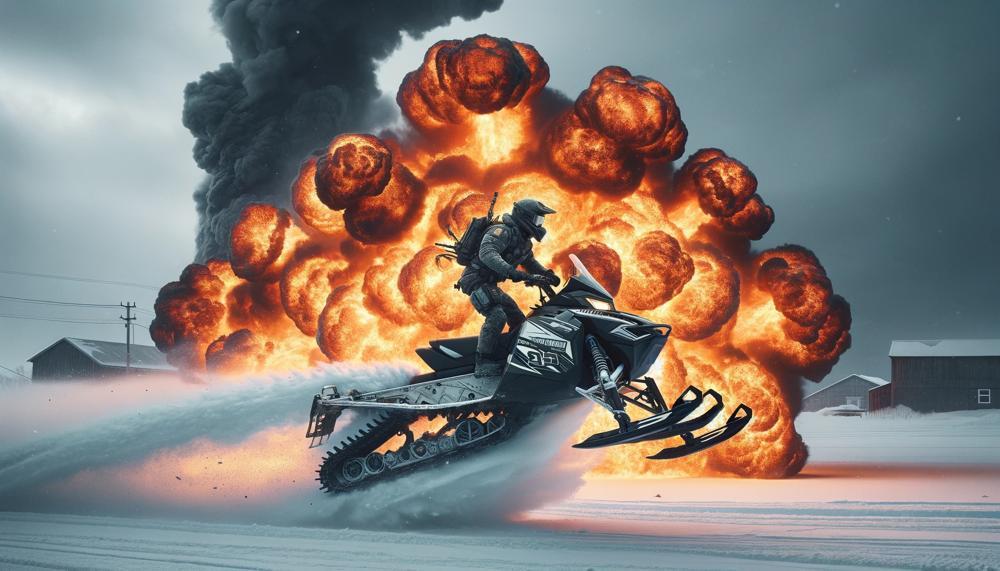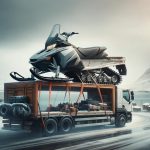Imagine this: you’re cruising through the snowy trails on your snowmobile, feeling the rush of adrenaline as you navigate through the winter wonderland. The crisp air fills your lungs and the stunning landscape surrounds you.
But suddenly, a loud bang and a fiery burst from your snowmobile’s exhaust shatters the tranquility – backfire.
Not only can backfires startle both you and fellow riders, but they can also be a warning sign of underlying engine problems. However, don’t let that ruin your ride. Dealing with snowmobile backfire doesn’t have to be daunting or complicated.
In fact, there are simple yet effective methods to prevent and handle backfires while still enjoying an exhilarating ride.
Here are some essential tips to keep in mind when it comes to effectively handling snowmobile backfire:
- Regular maintenance and tune-ups are crucial in preventing backfires by ensuring a smooth-running engine.
- Avoid using low-quality or old fuel as it can cause misfiring in the engine.
- Adjusting the air-fuel mixture on your carburetor can significantly reduce the chances of backfire.
- If you do experience a backfire while riding, remain calm and pull over to check for any potential issues before continuing.

Now that you know how to handle snowmobile backfire like a pro, let’s delve into these methods in more detail for a seamless riding experience.
Why do snowmobiles backfire?
Contents
- 1 Why do snowmobiles backfire?
- 2 Why does my snowmobile backfire when I turn it off?
- 3 What would cause a snowmobile to backfire?
- 4 Do backfires harm the snowmobile engine?
- 5 Effects of backfire
- 6 What does it mean when a snowmobile backfires?
- 7 Can bad spark plugs cause backfire?
- 8 What causes backfire at idle?
- 9 What should you do when your snowmobile backfires?
- 10 How to prevent snowmobile backfires?
- 11 Conclusion
Snowmobile backfires can be quite frustrating, especially when you’re out enjoying a ride in the snow. These sudden explosive sounds are caused by an imbalance in the engine’s fuel and air mixture. This can happen for various reasons, such as having too much fuel in the combustion chamber, a damaged catalytic converter, or misfiring spark plugs. Even using the wrong type of fuel or not shutting off the engine correctly can lead to backfires.
To avoid these disruptive backfires, regular maintenance of your sled is crucial. This includes using the recommended octane level of gasoline and keeping the carburetor clean to ensure a harmonious mix of fuel and air. It’s also essential to turn off the engine properly and allow it to idle before shutting it down.
Furthermore, impurities in the fuel can cause backfires as well. To prevent this from happening, always use clean and high-quality fuel. Additionally, keep a check on your ignition coils and spark plugs, as any damages or malfunctions can also contribute to backfires.
Why does my snowmobile backfire when I turn it off?
Snowmobiles often experience backfiring when excess fuel or air is present in the combustion chamber, resulting in a small explosion during the engine’s shutdown process. This issue can be caused by various factors, including problems with the spark plug, catalytic converter, or carburetor.
To effectively address this issue, proper maintenance of your snowmobile is crucial. Regularly checking for damaged parts that may contribute to backfiring and keeping your snowmobile in good condition can prevent this issue from occurring.
Here are some helpful tips for preventing backfiring:
| Issue | Cause |
| Spark Plug | A worn-out or damaged spark plug can cause an incomplete fuel burn and result in backfiring. |
| Catalytic Converter | If the catalytic converter is clogged or damaged, it can lead to backfiring as it hinders proper airflow. |
| Carburetor | A dirty or misadjusted carburetor can cause an improper fuel-air mixture, leading to backfiring. |
| Fuel Quality | Using old or contaminated fuel can lead to backfiring as it affects the fuel-air ratio. |
| Air Valves or Exhaust Pipes | Clogged air valves or exhaust pipes can disrupt proper airflow and cause backfiring. |
In order to resolve snowmobile backfiring, regular maintenance and checkups are essential. This includes keeping the spark plug and carburetor clean and correctly adjusted, using clean and high-quality fuel, and regularly inspecting for any damaged parts such as the catalytic converter or exhaust pipes.
If backfiring continues to occur frequently, it is best to seek the help of a mechanic for proper diagnosis and repair. Ignoring this issue can lead to further damage to the snowmobile’s engine and potentially cause harm to the rider or owner.
What would cause a snowmobile to backfire?
Snowmobile backfire is a frequent problem that can have many underlying causes. The most common culprits are an incorrect fuel-to-air ratio, faulty spark plugs, carburetor malfunctions, a damaged catalytic converter, and blockages in the exhaust pipe. To prevent snowmobile backfire, it is crucial to use the proper fuel and regularly inspect and maintain spark plugs and other components. It’s also essential to check for any obstructions in the exhaust pipe. If the issue persists, it is best to seek professional assistance.
One of the main reasons for snowmobile backfire is an incorrect fuel-to-air ratio. If there is too much air in the fuel mixture, the spark plug may not ignite the air-fuel mixture properly, leading to backfire. Similarly, if there is too much fuel in the mixture, it can cause incomplete combustion, resulting in backfire.
Another common cause of snowmobile backfire is faulty spark plugs. Over time, spark plugs can wear out or become fouled with carbon deposits, causing them to malfunction. This can lead to improper ignition of the air-fuel mixture and result in backfire. Regularly checking and replacing spark plugs can help prevent this issue.
Carburetor issues can also contribute to snowmobile backfire. If the carburetor is dirty or damaged, it may not be able to deliver the correct amount of fuel to the engine, causing an uneven fuel-to-air ratio and resulting in backfire. Regular maintenance of the carburetor can help prevent this issue.
A damaged catalytic converter can also cause snowmobile backfire. The catalytic converter helps convert harmful gases into less harmful ones before being released into the exhaust pipe. If it is damaged or clogged, it can lead to restricted airflow and cause backfire. Regularly inspecting and replacing a damaged catalytic converter can help avoid this problem.
Finally, obstructions in the exhaust pipe can cause snowmobile backfire. Debris, snow, or ice can get stuck in the exhaust pipe, blocking the flow of exhaust gases, and causing backfire. Regularly inspecting and clearing any obstructions can help prevent this issue.
Do backfires harm the snowmobile engine?
Snowmobile engine damage can be caused by backfires if they are not dealt with immediately. Backfiring is a sign of underlying issues, and if left untreated, can result in decreased fuel efficiency, power loss, and expensive damage. In order to prevent backfiring, it is crucial to understand the causes and how to address them.
To prevent snowmobile backfires and protect the engine, regular maintenance and using the correct fuel is key.
Seeking professional assistance for persistent issues is also recommended. In the event of a backfire while riding, it is important to stop and address the issue before continuing to avoid further damage.
By focusing on preventive measures and promptly addressing any problems, riders can ensure a smooth and enjoyable snowmobiling experience.
| Potential Causes of Snowmobile Backfires | Effects on Engine | Solutions |
| Faulty Fuel-to-Air Ratio | Can cause engine to run excessively rich or lean, resulting in backfiring and potential damage to internal components. | Adjusting the carburetor or seeking professional assistance to ensure the proper fuel-to-air ratio can help prevent backfires. |
| Faulty Spark Plugs | Incomplete combustion caused by faulty spark plugs can lead to backfiring and potential engine damage. | Replacing spark plugs regularly and seeking professional assistance if the issue persists can help prevent backfires. |
| Obstructions in Exhaust Pipe | Restrictions in airflow due to obstructions can cause backfiring and potential damage to the exhaust system. | Regularly checking for obstructions and clearing them out before riding can help prevent backfires. |
| Carburetor Issues | Imbalances in fuel-to-air mixture caused by carburetor issues can result in backfiring and potential engine damage. | Seeking professional assistance for proper carburetor adjustments can help prevent backfires. |
| Damage to Catalytic Converter | Restricted exhaust flow due to damaged catalytic converters can cause backfiring and potential engine damage. | Inspecting and replacing damaged catalytic converters can help prevent backfires. |
Overall, preventing backfires and potential engine damage on a snowmobile requires regular maintenance and using the right fuel. Seeking professional assistance for persistent issues is also recommended.
Effects of backfire
Backfiring in snowmobiles can have a myriad of consequences, ranging from minor engine damage to physical harm to the rider. This can result in costly repairs or even require a complete engine replacement. Some potential effects of backfiring on snowmobiles are:
- Engine Damage: The explosion caused by backfiring can cause serious damage to the engine, such as burnt valves, damaged piston rings, and cracked cylinder heads. This can lead to costly repairs or even require a complete engine replacement.
- Reduced Performance: A snowmobile that frequently backfires may experience a decrease in performance and power. This is because the explosion caused by backfiring disrupts the normal combustion process, resulting in reduced efficiency.
- Physical Harm: In rare cases, backfiring can also cause physical harm to the rider or owner of the snowmobile. The loud explosion and flames coming out of the exhaust can be startling and may cause the rider to lose control of the vehicle.
- Environmental Impact: Snowmobile backfire can also have negative impacts on the environment. It can release harmful pollutants into the air, contributing to air pollution and harming wildlife.
| Causes of Backfiring | Potential Consequences | Prevention/Management |
| Imbalance in fuel-air mixture | Engine damage, reduced performance | Regular maintenance, use proper fuel |
| Faulty spark plugs or other internal issues | Physical harm to rider, environmental impact | Seek professional assistance, address issues promptly |
What does it mean when a snowmobile backfires?
Snowmobile backfiring is a common issue that can have various causes and negative effects on the performance of the vehicle. Here are the most common causes of snowmobile backfire and how it can impact the overall riding experience and the environment.
One of the main culprits behind snowmobile backfire is an improper fuel-to-air ratio in the engine. This means that there is either an excess amount of fuel or a lack of air in the mixture that is being ignited, resulting in an explosion instead of a controlled burn. Consequently, this can lead to decreased fuel efficiency, loss of power, and expensive engine damage. To avoid this issue, it is crucial to use the correct type of fuel for your snowmobile and regularly maintain the spark plugs and carburetor to ensure a proper fuel-to-air ratio.
Another potential cause of snowmobile backfiring is a damaged catalytic converter. This component is responsible for converting harmful gases into less harmful ones, but if it becomes damaged or clogged, it can cause backfiring. To prevent this issue, regular maintenance and inspections are essential.
Similarly, an obstructed exhaust pipe can also result in snowmobile backfire. A blockage in the exhaust system can cause pressure to build up, leading to explosions instead of controlled burns. To avoid this issue, make sure to regularly check and clean the exhaust pipe.
Aside from posing a danger to the engine, snowmobile backfiring can also have adverse effects on the overall performance of the vehicle. It can lead to power loss, decreased fuel efficiency, and even physical harm to the rider. Furthermore, it can also have negative impacts on the environment by releasing excess pollutants into the air.
Can bad spark plugs cause backfire?
Although snowmobiles are designed to withstand harsh weather conditions and rugged terrain, they still require proper maintenance to function at their best. A crucial component in the ignition process of snowmobiles is the spark plug.
These small but mighty parts create a spark that ignites the air-fuel mixture in the combustion chamber, powering the engine. However, issues with spark plugs can lead to backfiring and cause damage to the vehicle.
One of the main culprits of backfiring in snowmobiles is faulty or dirty spark plugs. Over time, exposure to dirt, debris, and fuel additives can cause them to become worn or clogged. This can result in misfiring or weak sparks, leading to incomplete combustion and ultimately backfiring. Additionally, improperly installed spark plugs or incorrect spark plug gaps can also contribute to backfire.
To avoid backfiring caused by spark plugs, it is crucial to regularly inspect and clean or replace them according to the manufacturer’s recommendations. This will ensure proper ignition and prevent any potential damage to the engine. Furthermore, using the correct fuel and air-fuel mixture is essential in preventing backfire. Using low-quality or contaminated fuel can lead to an excess of fuel or air in the combustion chamber, causing backfire. Always use the recommended fuel type for your snowmobile and avoid using old or stale fuel.
What causes backfire at idle?
The issue of snowmobile backfire at idle is typically caused by an incorrect fuel-to-air ratio, faulty spark plugs, carburetor problems, damaged catalytic converters, or obstructions in the exhaust pipe. To avoid such backfiring, snowmobile owners should follow certain steps to ensure their vehicle’s proper functioning. These include using the recommended fuel and scheduling regular maintenance checks to ensure all parts are functioning correctly.
It is essential to address any backfiring immediately to prevent a decrease in fuel efficiency, loss of power, and costly damage to the engine. In fact, it is recommended to stop the snowmobile and have it towed instead of continuing to ride it. This will not only prevent further damage to the engine but also save on expensive repairs.
One of the main causes of snowmobile backfire at idle is an incorrect fuel-to-air ratio, whether it is too rich or too lean. To prevent this, snowmobile owners should use the recommended fuel and schedule regular maintenance checks. This will help ensure that the fuel-to-air ratio is within the correct range.
Another common cause of backfiring is faulty spark plugs. Regular cleaning or replacement of these spark plugs is crucial in preventing backfiring at idle. Snowmobile owners should also avoid using old or contaminated fuel, as this can also lead to faulty spark plugs.
Maintenance checks should also include inspecting and cleaning or replacing the carburetor when necessary. This can often be a contributing factor to backfiring issues. Additionally, avoiding excessive engine strain can help prevent damage to catalytic converters, another cause of backfire at idle.
Finally, regular maintenance checks should also include inspecting for any obstructions in the exhaust pipe. Riding through deep snow or debris can cause these obstructions, leading to backfiring at idle.
What should you do when your snowmobile backfires?
When your snowmobile backfires, it can be a frustrating and potentially dangerous experience. To effectively address this issue and prevent it from happening again, follow these steps:
- Identify the root cause: As mentioned previously, backfiring can be caused by a variety of factors such as improper fuel-to-air ratio, faulty spark plugs, issues with the carburetor, catalytic converter, or exhaust pipe. Identifying the underlying cause will help you take appropriate measures.
- Adjust the fuel mixture: If an unbalanced fuel-to-air ratio is causing the backfiring, adjust the mixture to the recommended level and regularly clean or replace the fuel filter.
- Consider altitude changes: Changes in altitude can impact air pressure and oxygen levels, resulting in backfiring. Adjusting the carburetor or using electronic fuel injection (EFI) systems can help prevent this issue.
- Maintain the carburetor: Regularly checking and maintaining the carburetor will ensure a proper balance of fuel and air. If necessary, have it adjusted by a professional mechanic.
- Inspect the ignition coil and stator: A damaged ignition coil or stator can lead to weak voltage and cause backfiring. Use a digital multimeter to check for any issues and replace if necessary.
- Check the condition of the spark plugs: Worn out or damaged spark plugs can cause weak sparks that do not properly ignite the fuel, resulting in backfiring. It is important to regularly replace them to prevent this issue.
- Inspect the wiring: Damaged wiring can cause short circuits that affect the electrical system of your snowmobile and lead to backfiring. Be sure to inspect and fix any damaged wiring to avoid this issue.
- Address bent valves: While rare, bent valves can also lead to backfiring and require professional repair to prevent further damage to the engine.
How to prevent snowmobile backfires?
Preventing snowmobile backfires is crucial for a smooth and enjoyable riding experience. To help you avoid this issue, here are some tips to keep in mind:
| Regularly check spark plugs | Spark plugs are essential for the ignition process of a snowmobile. Worn out or damaged spark plugs can lead to backfires. Be sure to regularly inspect and clean them, and replace them when necessary. |
| Monitor fuel mixture | An improper fuel mixture can also cause backfires. Refer to your manual to determine the recommended fuel type and octane level for your snowmobile. Avoid using additives as they can alter the fuel mixture. |
| Protect your vehicle from extreme weather | Harsh weather conditions, such as heavy snow or rain, can damage your snowmobile’s engine and exhaust system, resulting in backfires. Use a cover to shield it when not in use and store it in a closed space. |
| Maintain and care for your snowmobile regularly | Proper maintenance and care are vital to prevent backfiring and other issues. Regularly check and replace any faulty components, such as converters or carburetors. Additionally, remember to clean the air filter and change the oil according to the manufacturer’s instructions. |
| Adjust carburetor for altitude changes | Changes in altitude can affect the air-fuel ratio, leading to backfires. If you’re riding at higher altitudes, make sure to adjust the carburetor accordingly to maintain the proper fuel mixture. |
Conclusion
In summary, tackling snowmobile backfire doesn’t have to be a daunting task.
Keep in mind the importance of regular snowmobile upkeep, opting for high-quality fuel, and seeking expert help when needed to ensure a seamless and enjoyable experience on the trails.






